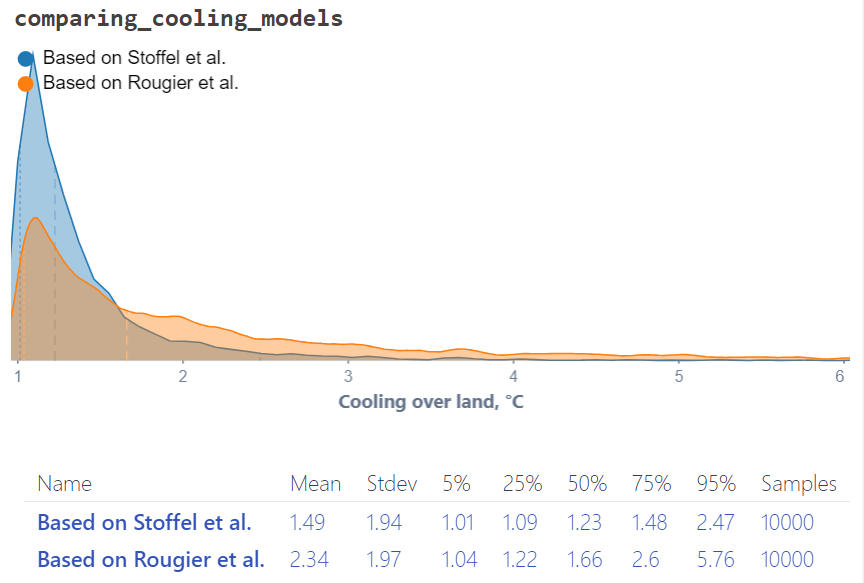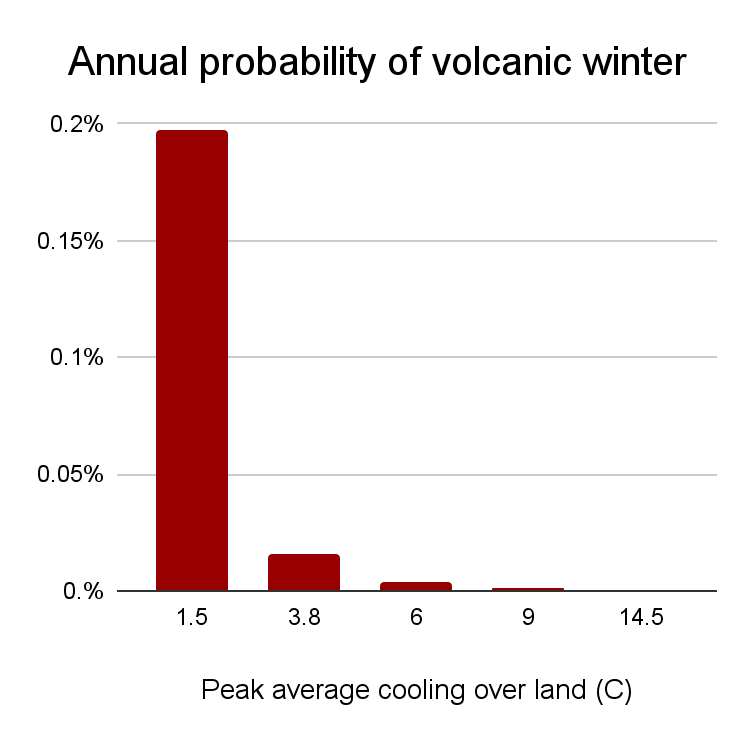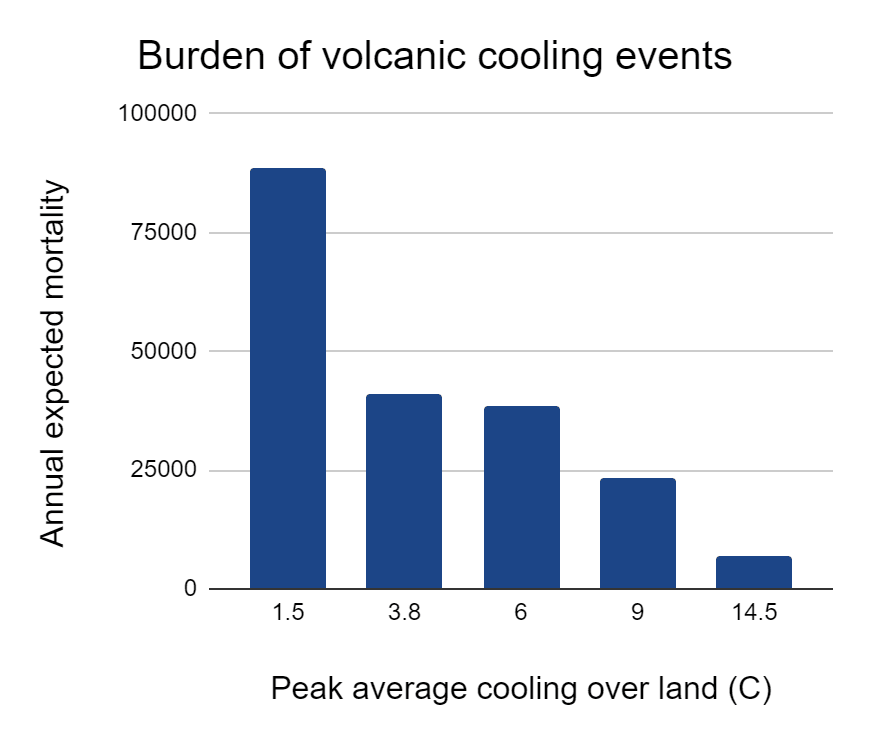This is scavenged and adapted from my report on global cooling catastrophes.
Summary
Earth's history has been punctuated with huge volcanic eruptions that have changed the climate. Volcanic cooling has happened before, and will happen again.
Oddly, volcanologists refrain from modeling the future risk of a global volcanic catastrophe. My model estimates the risk of volcanic cooling of over 1°C over land at about 20% per century.
Most of the expected damage of these catastrophes comes from milder events with 1-4°C of cooling. All together, I estimate the annualized burden at around 200,000 deaths per year. However, there is a lot of uncertainty about the risk, and associated damage, of global volcanic cooling events.
My main takeaway is that sub-super eruptions may represent a major global threat. Improving global food system resilience may be a good way to mitigate it.
Volcanic cooling - a regular occurrence
Large eruptions can eject millions of tonnes of material into the atmosphere. Sulfur dioxide reacts with water vapor, creating sulfate ions which reflect solar energy back into space. Ash blankets large regions, reflecting yet more energy away from Earth. This results in global cooling which can last years.
The eruption of Mt Pinatubo in 1991 had an estimated average global cooling effect of 0.5°C. It is the only measurable volcanic cooling event to have occurred in the era of reliable global temperature data; we are significantly more uncertain about everything that happened before. This makes it surprisingly difficult to estimate the future risk from volcanic cooling events.
The further back in time we look, the weaker the evidence base for estimating the cooling effects of historic eruptions. Tree-ring data is fairly reliable up to 2000-5000 years ago. Beyond this we rely on data from samples of air trapped in ancient ice. Annoyingly, ice-core and tree-ring simulations tend to diverge, raising concerns about the accuracy of both sources (Stoffel et al., 2015).
What we do know is that there have been much larger eruptions than Pinatubo (which was a 6 on the VEI scale), and they appear to happen fairly regularly. The Tambora eruption of 1815 was around 10x larger than Pinatubo (VEI7), and was probably the second such eruption of the millennium. Supereruptions (VEI8), which occur with a period of tens or hundreds of thousands of years, are around 10x larger still.
But magnitude (aka explosivity, the mass of matter ejected from the volcano) is not a great proxy for cooling effect. Sulfur dioxide emissions, which are only loosely correlated with magnitude, are the main source of cooling. Particulate matter has an additional effect which is difficult to model. It is generally agreed that above a certain threshold, cooling effect increases sublinearly with magnitude, and may even reach a natural limit. To add to the complexity, the location of the eruption is considered important, with high-latitude eruptions having up to 7x greater cooling effects.
Unfortunately, scientists tend to model volcanic risk in terms of explosivity, not cooling. This makes sense for smaller eruptions, for which explosivity is an OK proxy for how much local damage there might be. But for large eruptions the global cooling effects are far more important.
My model attempts to estimate volcanic cooling risk. It is undoubtedly crude, but it plants a flag in the ground: at the very least, volcanic cooling is something worth looking into.
How big is the threat?
Results
The annual risk of a volcanic cooling event of at least 1°C over land is about 1-in-500. The cooling distribution is very light-tailed.
The super-linear effect of cooling on damage means that the distribution of the burden is somewhat heavier-tailed. Most of the expected damage comes from events with 1-4°C of cooling over land.
Overall the annualized mortality burden of volcanic cooling events is around 200,000 deaths per year - more than die in an average year from all other natural disasters.
However, this estimate is very sensitive to how I model the mortality burden of mild cooling events. If the world is able to prevent famine in milder cooling events with 1-4°C of cooling over land, the annualized burden will be much lower.
Model
My model aims to mitigate uncertainty by averaging across multiple assumptions and multiple types of data.
The two distributional assumptions are:
- The degree of cooling in volcanic cooling events is exponentially distributed
- The degree of cooling in volcanic cooling events has a power-law distribution
The data sources are:
- Estimates of global temperature fluctuations in the past 1500 years from Stoffel et al (2015)[1]. I chose this paper as it was recommended by the volcano expert I consulted, and is notable in that it uses tree-ring and ice-core projections that agree with one another.
- The estimated relative frequencies of VEI7 and VEI8 eruptions from Rougier et al. (2018)[2], combined with modeling on the relationship between explosivity and cooling.
From each data source I produce a mixture of exponential and power-law distributions. Under each mixture I calculate the probabilities of cooling events of different magnitudes. For each magnitude I take the geometric mean of the probabilities under each data source.

Diagram: the distribution of cooling levels in volcanic events with at least 1°C of cooling over land, under models based on two different data sources. Rougier et al. data led to more severe cooling predictions, but lower annual risk predictions.
Our predictions should be interpreted with caution: data on moderate-to-severe volcanic cooling events is considered unreliable, and our model largely extrapolates from mild cooling scenarios of up to 1-2°C. By using exponential and power-law distributions, we assume that there is no ceiling on how severe volcanic events can be.
Conclusion
My model is a crude one, but it highlights the lack of more robust efforts to enumerate the risk of global volcanic cooling events. More work, by specialist researchers, is needed to better evaluate whether volcanic risk is worth taking more seriously.
- ^
By eyeballing Fig. 1d it appears that (A) 1+ degree cooling events happen with a period of 150 years, (B) 1.5+ degree cooling events happen with a period of 500 years, and (C) 2+ degree cooling events happen with a period of 3000 years.
- ^
This paper provides 95% confidence intervals for the periods of VEI7 eruptions of (680, 2100) years, and (5200,48000) years for VEI 8 eruptions.



We shall prepare for electromagnetic pulse events and for cooling events because additionally to the natural risk, they are consequences of a potential nuclear war.